Supply Chain Management and Information System: A Detailed Report
VerifiedAdded on 2023/01/18
|9
|2213
|40
Report
AI Summary
This report provides a literature review of supply chain management (SCM) and the role of information systems (IS) within it. The abstract highlights the critical role of SCM and IS in reducing costs and increasing supply chain efficiency. The literature review examines how IS supports collaboration, reduces the bullwhip effect, enhances operational efficiency, and supports strategic planning within SCM. The report discusses the capabilities of IS in enabling organizational strategies, particularly focusing on operational efficiency and flexibility. It explores the impact of IS, such as EDI and ERP systems, on supply chain processes and performance, including the importance of internal and external integration. The conclusion emphasizes the benefits and considerations for implementing IS in SCM, highlighting the need for accurate information coordination and the ability to adapt to changing market demands. The report references several studies and research papers to support its findings and provides a comprehensive overview of the subject.
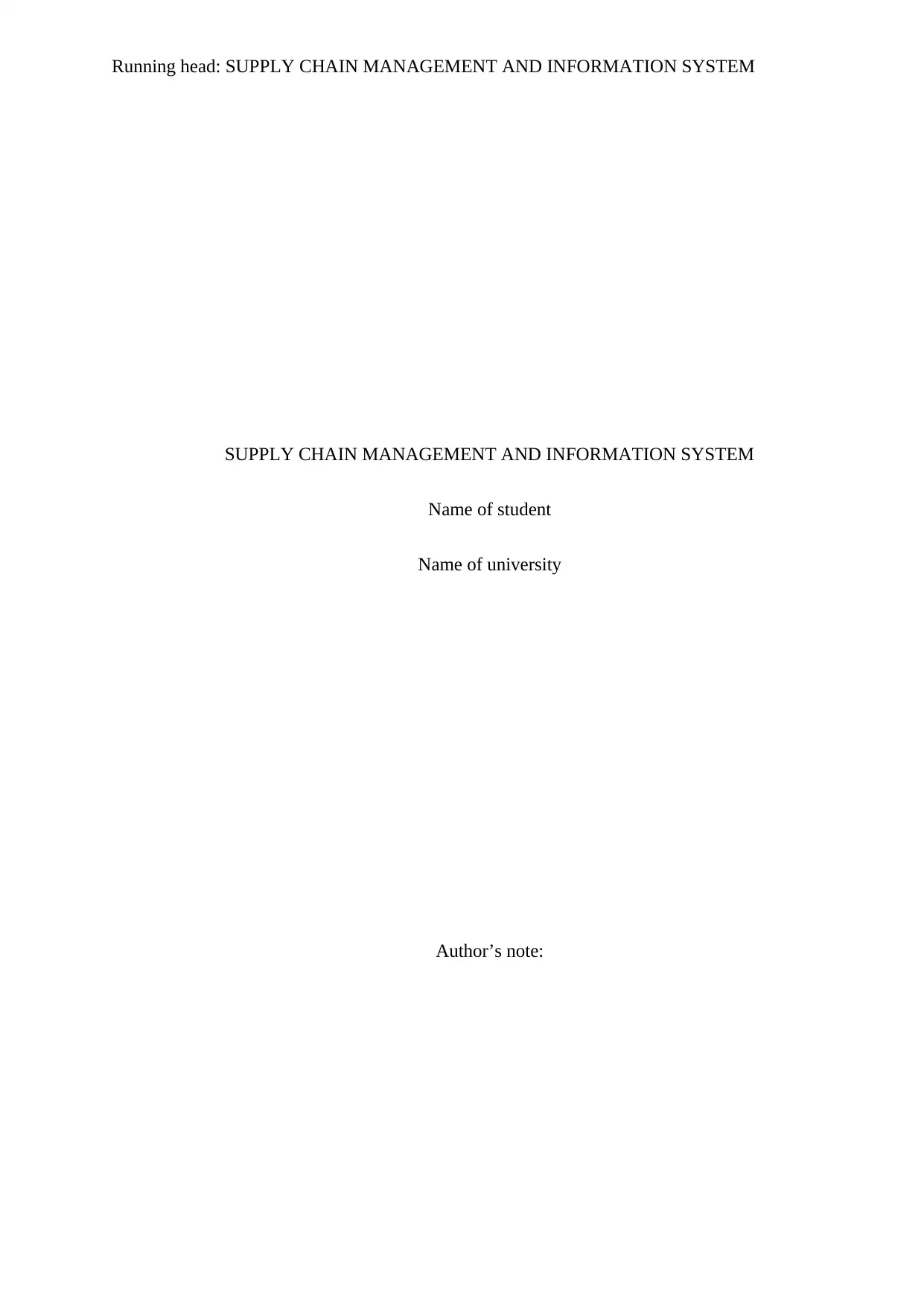
Running head: SUPPLY CHAIN MANAGEMENT AND INFORMATION SYSTEM
SUPPLY CHAIN MANAGEMENT AND INFORMATION SYSTEM
Name of student
Name of university
Author’s note:
SUPPLY CHAIN MANAGEMENT AND INFORMATION SYSTEM
Name of student
Name of university
Author’s note:
Paraphrase This Document
Need a fresh take? Get an instant paraphrase of this document with our AI Paraphraser
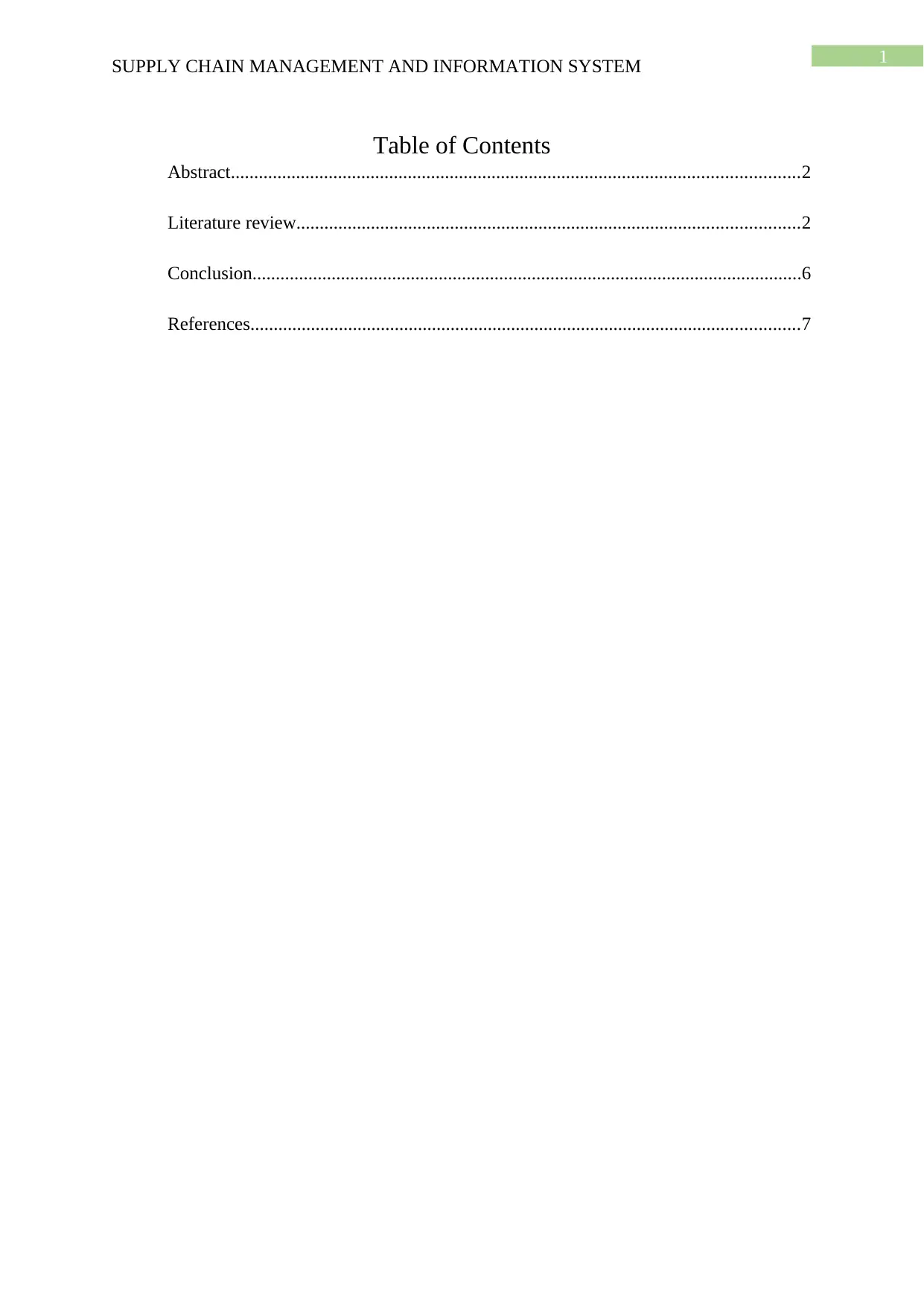
1
SUPPLY CHAIN MANAGEMENT AND INFORMATION SYSTEM
Table of Contents
Abstract..........................................................................................................................2
Literature review............................................................................................................2
Conclusion......................................................................................................................6
References......................................................................................................................7
SUPPLY CHAIN MANAGEMENT AND INFORMATION SYSTEM
Table of Contents
Abstract..........................................................................................................................2
Literature review............................................................................................................2
Conclusion......................................................................................................................6
References......................................................................................................................7
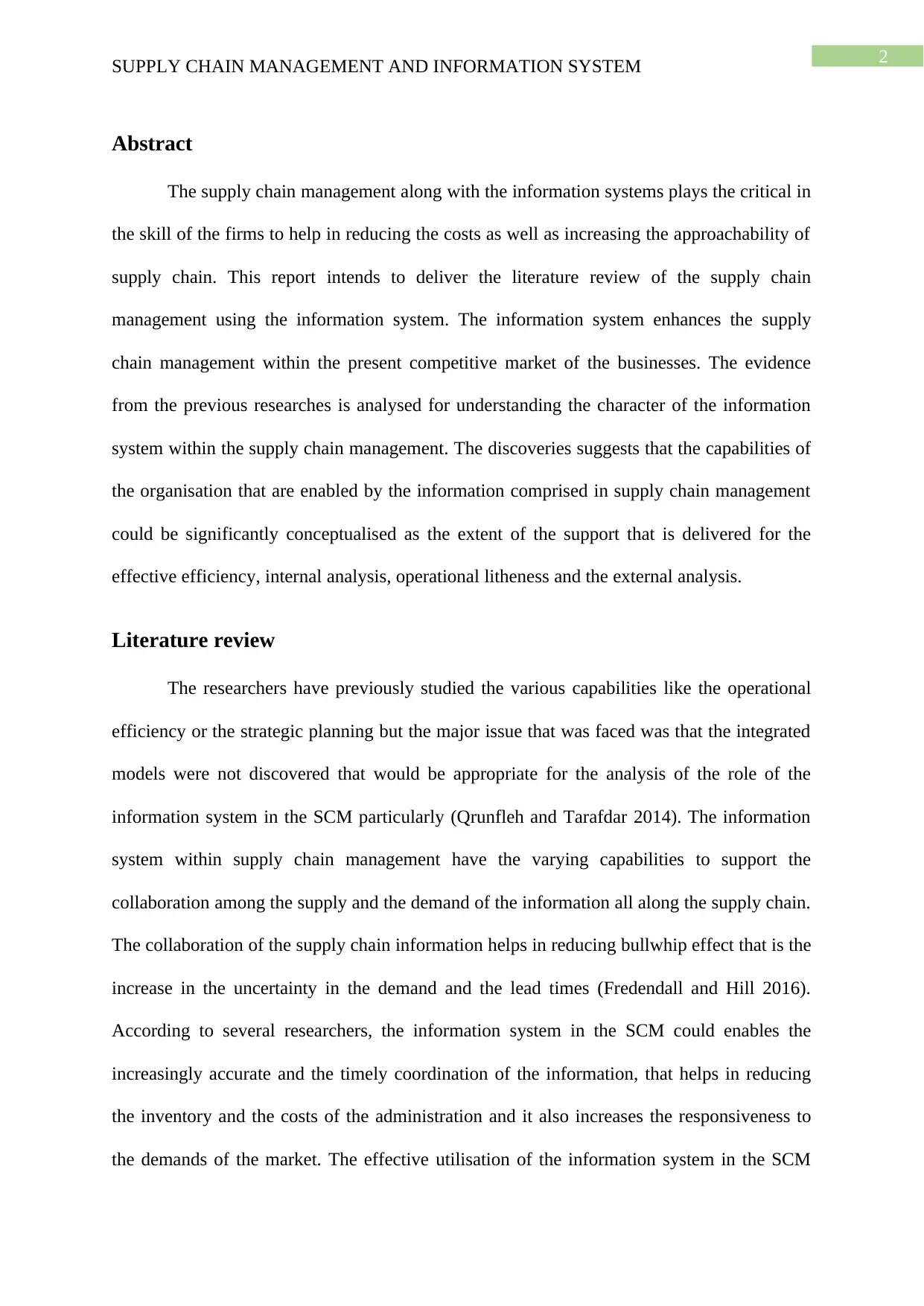
2
SUPPLY CHAIN MANAGEMENT AND INFORMATION SYSTEM
Abstract
The supply chain management along with the information systems plays the critical in
the skill of the firms to help in reducing the costs as well as increasing the approachability of
supply chain. This report intends to deliver the literature review of the supply chain
management using the information system. The information system enhances the supply
chain management within the present competitive market of the businesses. The evidence
from the previous researches is analysed for understanding the character of the information
system within the supply chain management. The discoveries suggests that the capabilities of
the organisation that are enabled by the information comprised in supply chain management
could be significantly conceptualised as the extent of the support that is delivered for the
effective efficiency, internal analysis, operational litheness and the external analysis.
Literature review
The researchers have previously studied the various capabilities like the operational
efficiency or the strategic planning but the major issue that was faced was that the integrated
models were not discovered that would be appropriate for the analysis of the role of the
information system in the SCM particularly (Qrunfleh and Tarafdar 2014). The information
system within supply chain management have the varying capabilities to support the
collaboration among the supply and the demand of the information all along the supply chain.
The collaboration of the supply chain information helps in reducing bullwhip effect that is the
increase in the uncertainty in the demand and the lead times (Fredendall and Hill 2016).
According to several researchers, the information system in the SCM could enables the
increasingly accurate and the timely coordination of the information, that helps in reducing
the inventory and the costs of the administration and it also increases the responsiveness to
the demands of the market. The effective utilisation of the information system in the SCM
SUPPLY CHAIN MANAGEMENT AND INFORMATION SYSTEM
Abstract
The supply chain management along with the information systems plays the critical in
the skill of the firms to help in reducing the costs as well as increasing the approachability of
supply chain. This report intends to deliver the literature review of the supply chain
management using the information system. The information system enhances the supply
chain management within the present competitive market of the businesses. The evidence
from the previous researches is analysed for understanding the character of the information
system within the supply chain management. The discoveries suggests that the capabilities of
the organisation that are enabled by the information comprised in supply chain management
could be significantly conceptualised as the extent of the support that is delivered for the
effective efficiency, internal analysis, operational litheness and the external analysis.
Literature review
The researchers have previously studied the various capabilities like the operational
efficiency or the strategic planning but the major issue that was faced was that the integrated
models were not discovered that would be appropriate for the analysis of the role of the
information system in the SCM particularly (Qrunfleh and Tarafdar 2014). The information
system within supply chain management have the varying capabilities to support the
collaboration among the supply and the demand of the information all along the supply chain.
The collaboration of the supply chain information helps in reducing bullwhip effect that is the
increase in the uncertainty in the demand and the lead times (Fredendall and Hill 2016).
According to several researchers, the information system in the SCM could enables the
increasingly accurate and the timely coordination of the information, that helps in reducing
the inventory and the costs of the administration and it also increases the responsiveness to
the demands of the market. The effective utilisation of the information system in the SCM
⊘ This is a preview!⊘
Do you want full access?
Subscribe today to unlock all pages.

Trusted by 1+ million students worldwide
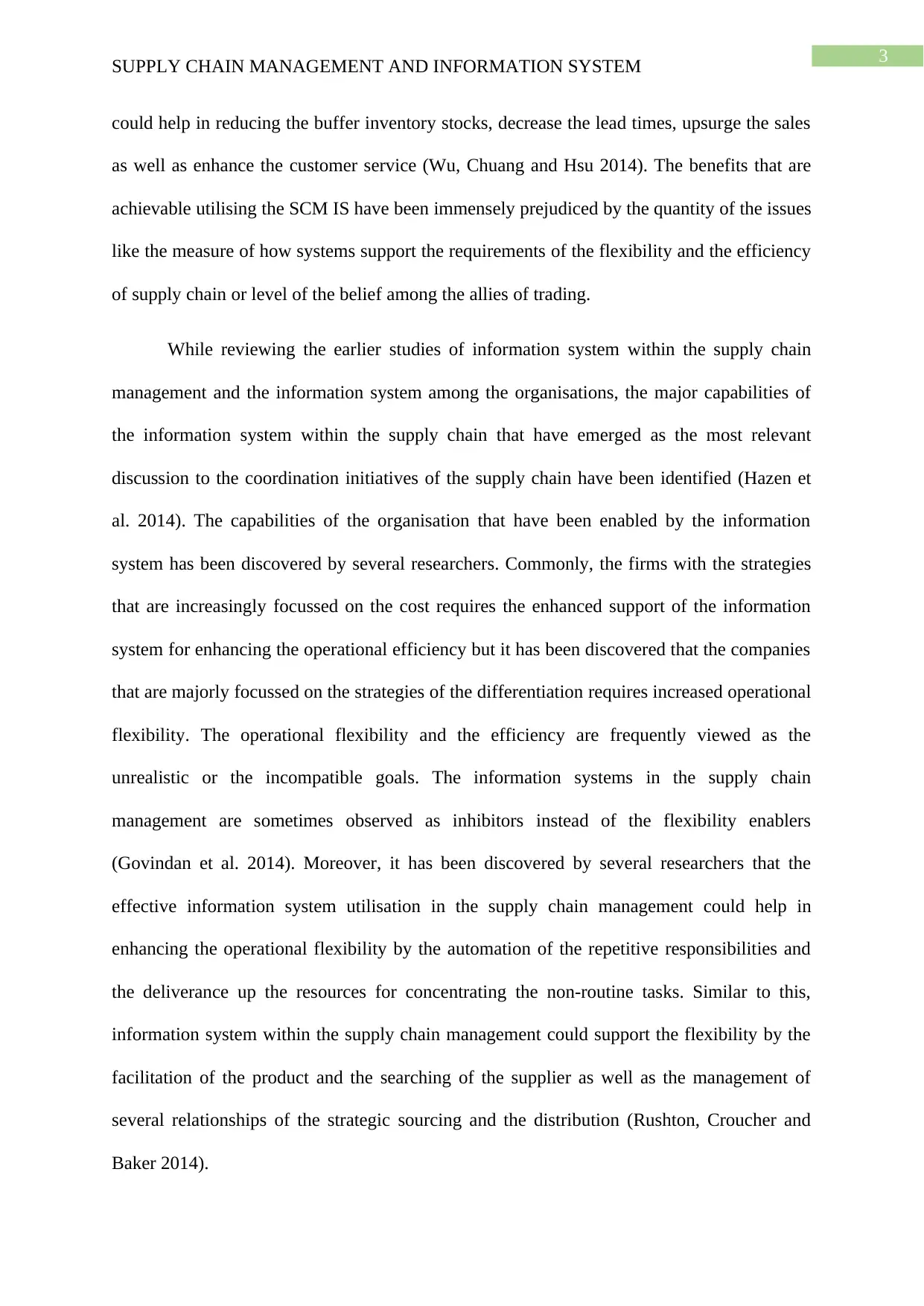
3
SUPPLY CHAIN MANAGEMENT AND INFORMATION SYSTEM
could help in reducing the buffer inventory stocks, decrease the lead times, upsurge the sales
as well as enhance the customer service (Wu, Chuang and Hsu 2014). The benefits that are
achievable utilising the SCM IS have been immensely prejudiced by the quantity of the issues
like the measure of how systems support the requirements of the flexibility and the efficiency
of supply chain or level of the belief among the allies of trading.
While reviewing the earlier studies of information system within the supply chain
management and the information system among the organisations, the major capabilities of
the information system within the supply chain that have emerged as the most relevant
discussion to the coordination initiatives of the supply chain have been identified (Hazen et
al. 2014). The capabilities of the organisation that have been enabled by the information
system has been discovered by several researchers. Commonly, the firms with the strategies
that are increasingly focussed on the cost requires the enhanced support of the information
system for enhancing the operational efficiency but it has been discovered that the companies
that are majorly focussed on the strategies of the differentiation requires increased operational
flexibility. The operational flexibility and the efficiency are frequently viewed as the
unrealistic or the incompatible goals. The information systems in the supply chain
management are sometimes observed as inhibitors instead of the flexibility enablers
(Govindan et al. 2014). Moreover, it has been discovered by several researchers that the
effective information system utilisation in the supply chain management could help in
enhancing the operational flexibility by the automation of the repetitive responsibilities and
the deliverance up the resources for concentrating the non-routine tasks. Similar to this,
information system within the supply chain management could support the flexibility by the
facilitation of the product and the searching of the supplier as well as the management of
several relationships of the strategic sourcing and the distribution (Rushton, Croucher and
Baker 2014).
SUPPLY CHAIN MANAGEMENT AND INFORMATION SYSTEM
could help in reducing the buffer inventory stocks, decrease the lead times, upsurge the sales
as well as enhance the customer service (Wu, Chuang and Hsu 2014). The benefits that are
achievable utilising the SCM IS have been immensely prejudiced by the quantity of the issues
like the measure of how systems support the requirements of the flexibility and the efficiency
of supply chain or level of the belief among the allies of trading.
While reviewing the earlier studies of information system within the supply chain
management and the information system among the organisations, the major capabilities of
the information system within the supply chain that have emerged as the most relevant
discussion to the coordination initiatives of the supply chain have been identified (Hazen et
al. 2014). The capabilities of the organisation that have been enabled by the information
system has been discovered by several researchers. Commonly, the firms with the strategies
that are increasingly focussed on the cost requires the enhanced support of the information
system for enhancing the operational efficiency but it has been discovered that the companies
that are majorly focussed on the strategies of the differentiation requires increased operational
flexibility. The operational flexibility and the efficiency are frequently viewed as the
unrealistic or the incompatible goals. The information systems in the supply chain
management are sometimes observed as inhibitors instead of the flexibility enablers
(Govindan et al. 2014). Moreover, it has been discovered by several researchers that the
effective information system utilisation in the supply chain management could help in
enhancing the operational flexibility by the automation of the repetitive responsibilities and
the deliverance up the resources for concentrating the non-routine tasks. Similar to this,
information system within the supply chain management could support the flexibility by the
facilitation of the product and the searching of the supplier as well as the management of
several relationships of the strategic sourcing and the distribution (Rushton, Croucher and
Baker 2014).
Paraphrase This Document
Need a fresh take? Get an instant paraphrase of this document with our AI Paraphraser
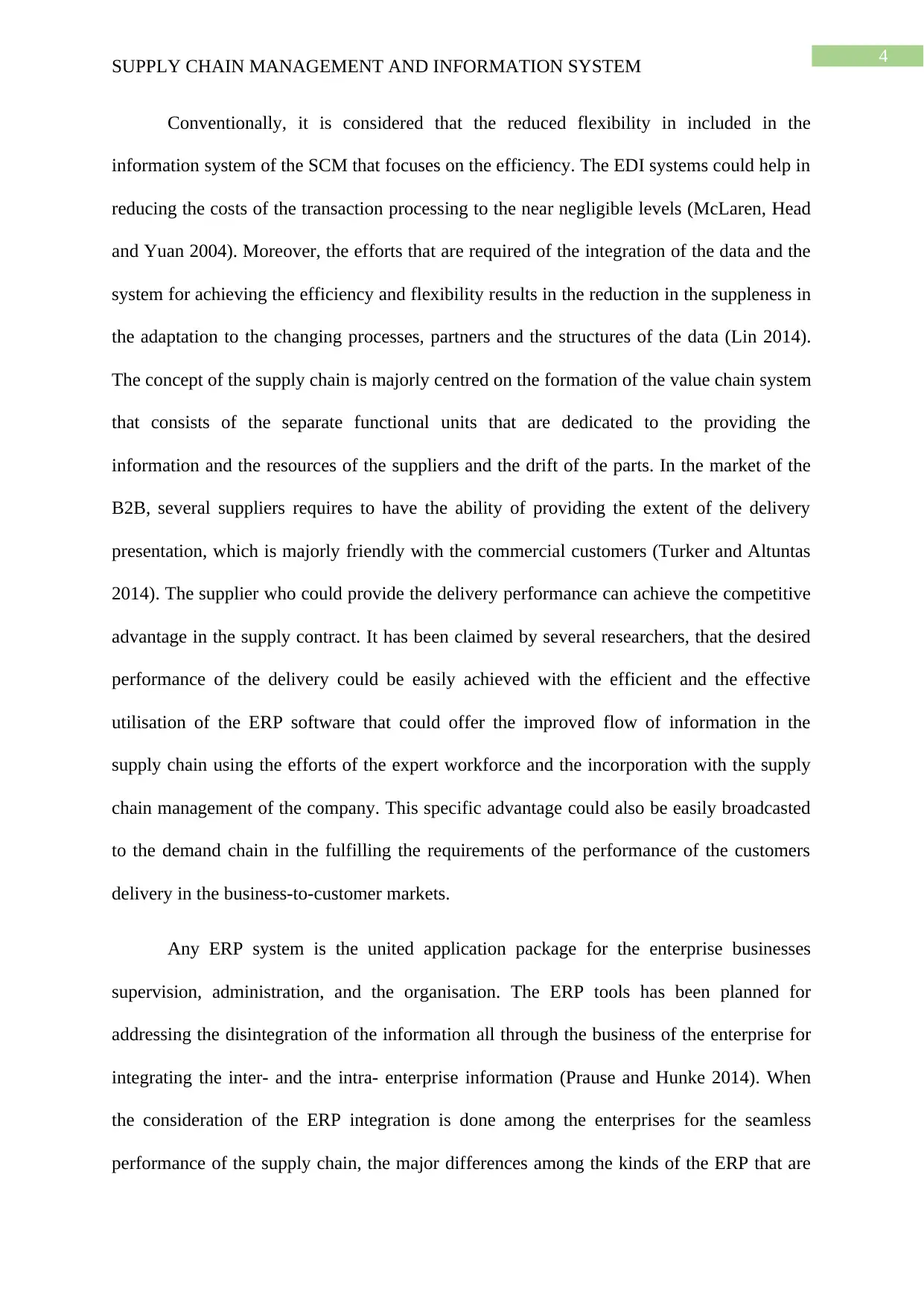
4
SUPPLY CHAIN MANAGEMENT AND INFORMATION SYSTEM
Conventionally, it is considered that the reduced flexibility in included in the
information system of the SCM that focuses on the efficiency. The EDI systems could help in
reducing the costs of the transaction processing to the near negligible levels (McLaren, Head
and Yuan 2004). Moreover, the efforts that are required of the integration of the data and the
system for achieving the efficiency and flexibility results in the reduction in the suppleness in
the adaptation to the changing processes, partners and the structures of the data (Lin 2014).
The concept of the supply chain is majorly centred on the formation of the value chain system
that consists of the separate functional units that are dedicated to the providing the
information and the resources of the suppliers and the drift of the parts. In the market of the
B2B, several suppliers requires to have the ability of providing the extent of the delivery
presentation, which is majorly friendly with the commercial customers (Turker and Altuntas
2014). The supplier who could provide the delivery performance can achieve the competitive
advantage in the supply contract. It has been claimed by several researchers, that the desired
performance of the delivery could be easily achieved with the efficient and the effective
utilisation of the ERP software that could offer the improved flow of information in the
supply chain using the efforts of the expert workforce and the incorporation with the supply
chain management of the company. This specific advantage could also be easily broadcasted
to the demand chain in the fulfilling the requirements of the performance of the customers
delivery in the business-to-customer markets.
Any ERP system is the united application package for the enterprise businesses
supervision, administration, and the organisation. The ERP tools has been planned for
addressing the disintegration of the information all through the business of the enterprise for
integrating the inter- and the intra- enterprise information (Prause and Hunke 2014). When
the consideration of the ERP integration is done among the enterprises for the seamless
performance of the supply chain, the major differences among the kinds of the ERP that are
SUPPLY CHAIN MANAGEMENT AND INFORMATION SYSTEM
Conventionally, it is considered that the reduced flexibility in included in the
information system of the SCM that focuses on the efficiency. The EDI systems could help in
reducing the costs of the transaction processing to the near negligible levels (McLaren, Head
and Yuan 2004). Moreover, the efforts that are required of the integration of the data and the
system for achieving the efficiency and flexibility results in the reduction in the suppleness in
the adaptation to the changing processes, partners and the structures of the data (Lin 2014).
The concept of the supply chain is majorly centred on the formation of the value chain system
that consists of the separate functional units that are dedicated to the providing the
information and the resources of the suppliers and the drift of the parts. In the market of the
B2B, several suppliers requires to have the ability of providing the extent of the delivery
presentation, which is majorly friendly with the commercial customers (Turker and Altuntas
2014). The supplier who could provide the delivery performance can achieve the competitive
advantage in the supply contract. It has been claimed by several researchers, that the desired
performance of the delivery could be easily achieved with the efficient and the effective
utilisation of the ERP software that could offer the improved flow of information in the
supply chain using the efforts of the expert workforce and the incorporation with the supply
chain management of the company. This specific advantage could also be easily broadcasted
to the demand chain in the fulfilling the requirements of the performance of the customers
delivery in the business-to-customer markets.
Any ERP system is the united application package for the enterprise businesses
supervision, administration, and the organisation. The ERP tools has been planned for
addressing the disintegration of the information all through the business of the enterprise for
integrating the inter- and the intra- enterprise information (Prause and Hunke 2014). When
the consideration of the ERP integration is done among the enterprises for the seamless
performance of the supply chain, the major differences among the kinds of the ERP that are
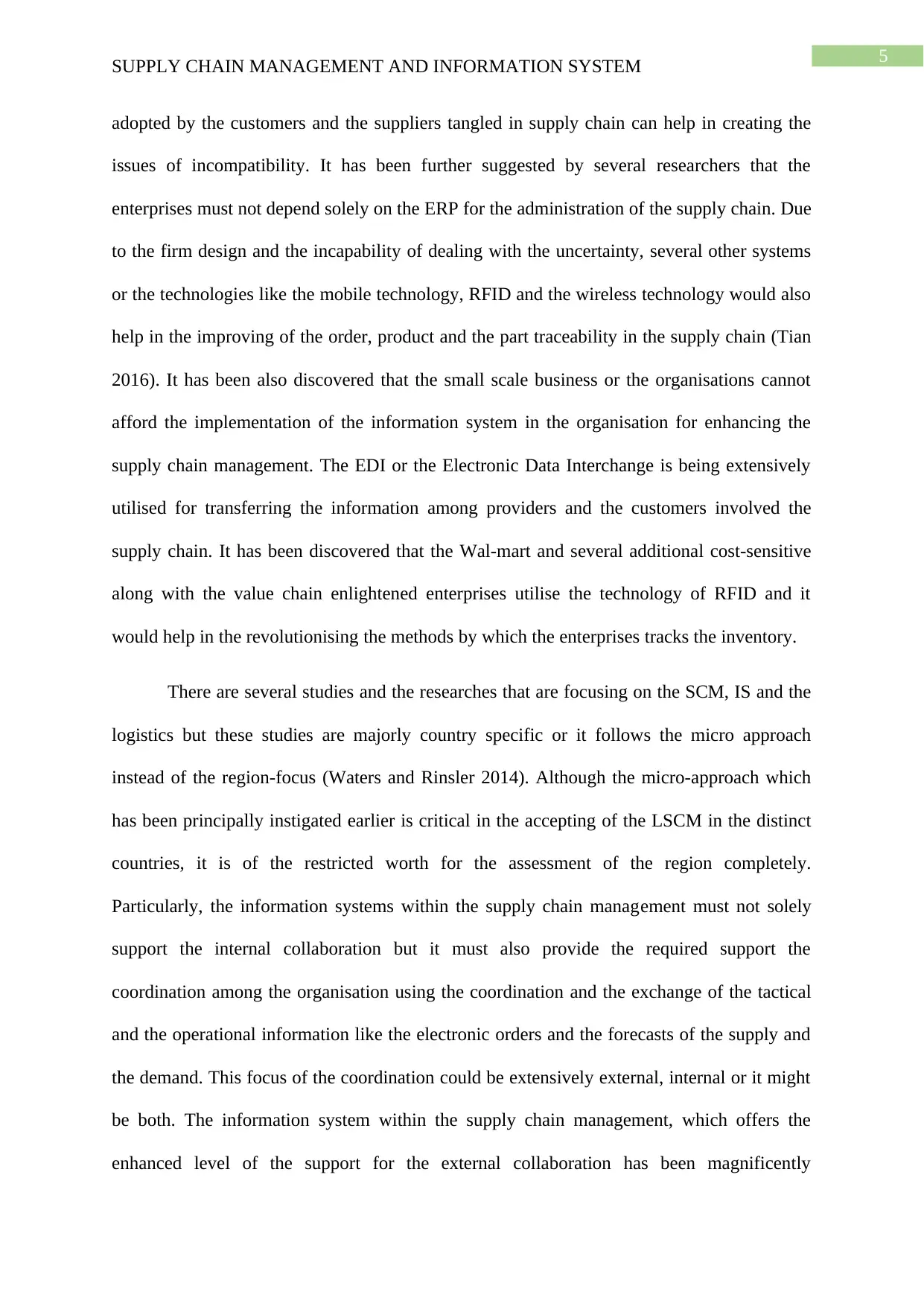
5
SUPPLY CHAIN MANAGEMENT AND INFORMATION SYSTEM
adopted by the customers and the suppliers tangled in supply chain can help in creating the
issues of incompatibility. It has been further suggested by several researchers that the
enterprises must not depend solely on the ERP for the administration of the supply chain. Due
to the firm design and the incapability of dealing with the uncertainty, several other systems
or the technologies like the mobile technology, RFID and the wireless technology would also
help in the improving of the order, product and the part traceability in the supply chain (Tian
2016). It has been also discovered that the small scale business or the organisations cannot
afford the implementation of the information system in the organisation for enhancing the
supply chain management. The EDI or the Electronic Data Interchange is being extensively
utilised for transferring the information among providers and the customers involved the
supply chain. It has been discovered that the Wal-mart and several additional cost-sensitive
along with the value chain enlightened enterprises utilise the technology of RFID and it
would help in the revolutionising the methods by which the enterprises tracks the inventory.
There are several studies and the researches that are focusing on the SCM, IS and the
logistics but these studies are majorly country specific or it follows the micro approach
instead of the region-focus (Waters and Rinsler 2014). Although the micro-approach which
has been principally instigated earlier is critical in the accepting of the LSCM in the distinct
countries, it is of the restricted worth for the assessment of the region completely.
Particularly, the information systems within the supply chain management must not solely
support the internal collaboration but it must also provide the required support the
coordination among the organisation using the coordination and the exchange of the tactical
and the operational information like the electronic orders and the forecasts of the supply and
the demand. This focus of the coordination could be extensively external, internal or it might
be both. The information system within the supply chain management, which offers the
enhanced level of the support for the external collaboration has been magnificently
SUPPLY CHAIN MANAGEMENT AND INFORMATION SYSTEM
adopted by the customers and the suppliers tangled in supply chain can help in creating the
issues of incompatibility. It has been further suggested by several researchers that the
enterprises must not depend solely on the ERP for the administration of the supply chain. Due
to the firm design and the incapability of dealing with the uncertainty, several other systems
or the technologies like the mobile technology, RFID and the wireless technology would also
help in the improving of the order, product and the part traceability in the supply chain (Tian
2016). It has been also discovered that the small scale business or the organisations cannot
afford the implementation of the information system in the organisation for enhancing the
supply chain management. The EDI or the Electronic Data Interchange is being extensively
utilised for transferring the information among providers and the customers involved the
supply chain. It has been discovered that the Wal-mart and several additional cost-sensitive
along with the value chain enlightened enterprises utilise the technology of RFID and it
would help in the revolutionising the methods by which the enterprises tracks the inventory.
There are several studies and the researches that are focusing on the SCM, IS and the
logistics but these studies are majorly country specific or it follows the micro approach
instead of the region-focus (Waters and Rinsler 2014). Although the micro-approach which
has been principally instigated earlier is critical in the accepting of the LSCM in the distinct
countries, it is of the restricted worth for the assessment of the region completely.
Particularly, the information systems within the supply chain management must not solely
support the internal collaboration but it must also provide the required support the
coordination among the organisation using the coordination and the exchange of the tactical
and the operational information like the electronic orders and the forecasts of the supply and
the demand. This focus of the coordination could be extensively external, internal or it might
be both. The information system within the supply chain management, which offers the
enhanced level of the support for the external collaboration has been magnificently
⊘ This is a preview!⊘
Do you want full access?
Subscribe today to unlock all pages.

Trusted by 1+ million students worldwide
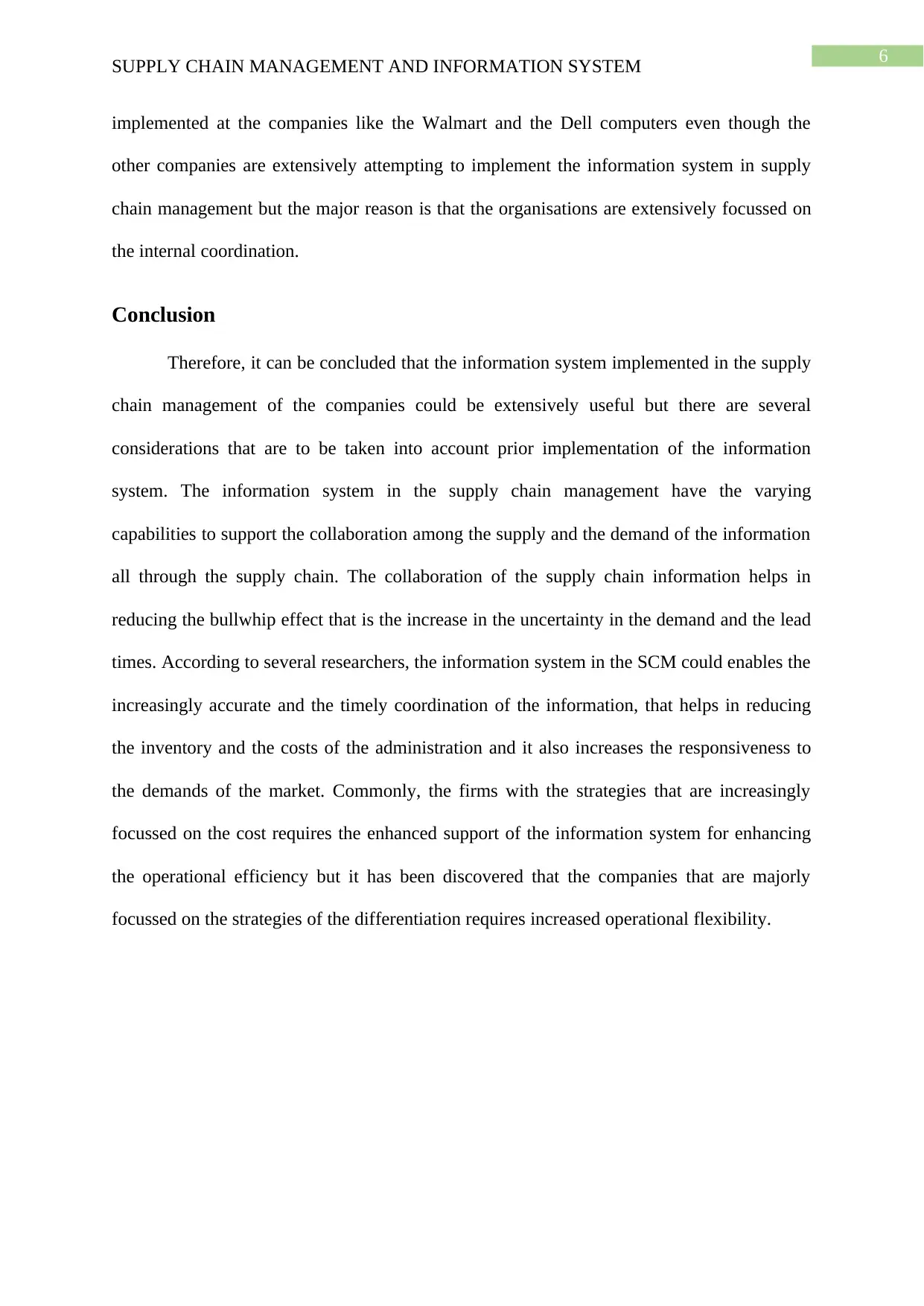
6
SUPPLY CHAIN MANAGEMENT AND INFORMATION SYSTEM
implemented at the companies like the Walmart and the Dell computers even though the
other companies are extensively attempting to implement the information system in supply
chain management but the major reason is that the organisations are extensively focussed on
the internal coordination.
Conclusion
Therefore, it can be concluded that the information system implemented in the supply
chain management of the companies could be extensively useful but there are several
considerations that are to be taken into account prior implementation of the information
system. The information system in the supply chain management have the varying
capabilities to support the collaboration among the supply and the demand of the information
all through the supply chain. The collaboration of the supply chain information helps in
reducing the bullwhip effect that is the increase in the uncertainty in the demand and the lead
times. According to several researchers, the information system in the SCM could enables the
increasingly accurate and the timely coordination of the information, that helps in reducing
the inventory and the costs of the administration and it also increases the responsiveness to
the demands of the market. Commonly, the firms with the strategies that are increasingly
focussed on the cost requires the enhanced support of the information system for enhancing
the operational efficiency but it has been discovered that the companies that are majorly
focussed on the strategies of the differentiation requires increased operational flexibility.
SUPPLY CHAIN MANAGEMENT AND INFORMATION SYSTEM
implemented at the companies like the Walmart and the Dell computers even though the
other companies are extensively attempting to implement the information system in supply
chain management but the major reason is that the organisations are extensively focussed on
the internal coordination.
Conclusion
Therefore, it can be concluded that the information system implemented in the supply
chain management of the companies could be extensively useful but there are several
considerations that are to be taken into account prior implementation of the information
system. The information system in the supply chain management have the varying
capabilities to support the collaboration among the supply and the demand of the information
all through the supply chain. The collaboration of the supply chain information helps in
reducing the bullwhip effect that is the increase in the uncertainty in the demand and the lead
times. According to several researchers, the information system in the SCM could enables the
increasingly accurate and the timely coordination of the information, that helps in reducing
the inventory and the costs of the administration and it also increases the responsiveness to
the demands of the market. Commonly, the firms with the strategies that are increasingly
focussed on the cost requires the enhanced support of the information system for enhancing
the operational efficiency but it has been discovered that the companies that are majorly
focussed on the strategies of the differentiation requires increased operational flexibility.
Paraphrase This Document
Need a fresh take? Get an instant paraphrase of this document with our AI Paraphraser
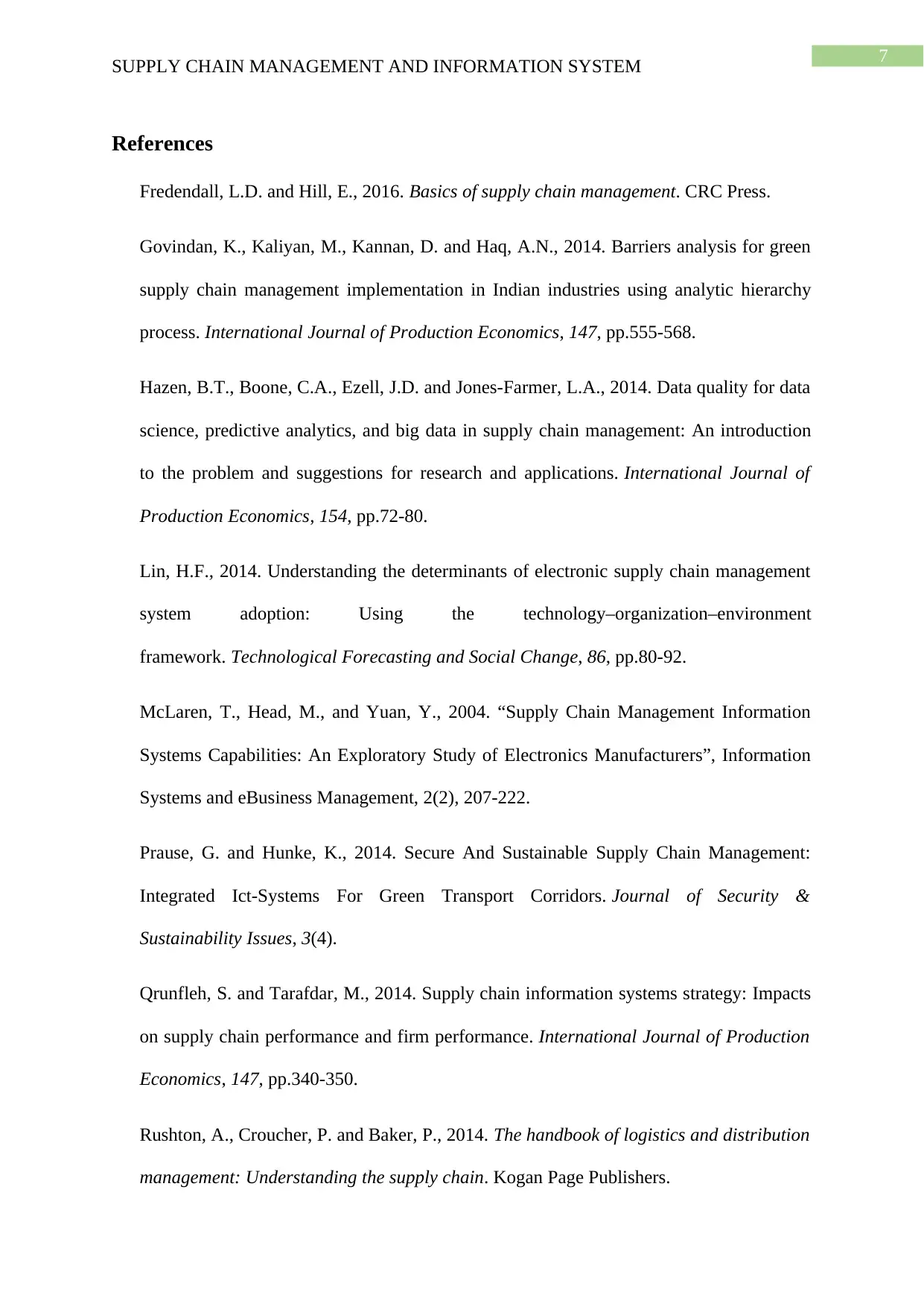
7
SUPPLY CHAIN MANAGEMENT AND INFORMATION SYSTEM
References
Fredendall, L.D. and Hill, E., 2016. Basics of supply chain management. CRC Press.
Govindan, K., Kaliyan, M., Kannan, D. and Haq, A.N., 2014. Barriers analysis for green
supply chain management implementation in Indian industries using analytic hierarchy
process. International Journal of Production Economics, 147, pp.555-568.
Hazen, B.T., Boone, C.A., Ezell, J.D. and Jones-Farmer, L.A., 2014. Data quality for data
science, predictive analytics, and big data in supply chain management: An introduction
to the problem and suggestions for research and applications. International Journal of
Production Economics, 154, pp.72-80.
Lin, H.F., 2014. Understanding the determinants of electronic supply chain management
system adoption: Using the technology–organization–environment
framework. Technological Forecasting and Social Change, 86, pp.80-92.
McLaren, T., Head, M., and Yuan, Y., 2004. “Supply Chain Management Information
Systems Capabilities: An Exploratory Study of Electronics Manufacturers”, Information
Systems and eBusiness Management, 2(2), 207-222.
Prause, G. and Hunke, K., 2014. Secure And Sustainable Supply Chain Management:
Integrated Ict-Systems For Green Transport Corridors. Journal of Security &
Sustainability Issues, 3(4).
Qrunfleh, S. and Tarafdar, M., 2014. Supply chain information systems strategy: Impacts
on supply chain performance and firm performance. International Journal of Production
Economics, 147, pp.340-350.
Rushton, A., Croucher, P. and Baker, P., 2014. The handbook of logistics and distribution
management: Understanding the supply chain. Kogan Page Publishers.
SUPPLY CHAIN MANAGEMENT AND INFORMATION SYSTEM
References
Fredendall, L.D. and Hill, E., 2016. Basics of supply chain management. CRC Press.
Govindan, K., Kaliyan, M., Kannan, D. and Haq, A.N., 2014. Barriers analysis for green
supply chain management implementation in Indian industries using analytic hierarchy
process. International Journal of Production Economics, 147, pp.555-568.
Hazen, B.T., Boone, C.A., Ezell, J.D. and Jones-Farmer, L.A., 2014. Data quality for data
science, predictive analytics, and big data in supply chain management: An introduction
to the problem and suggestions for research and applications. International Journal of
Production Economics, 154, pp.72-80.
Lin, H.F., 2014. Understanding the determinants of electronic supply chain management
system adoption: Using the technology–organization–environment
framework. Technological Forecasting and Social Change, 86, pp.80-92.
McLaren, T., Head, M., and Yuan, Y., 2004. “Supply Chain Management Information
Systems Capabilities: An Exploratory Study of Electronics Manufacturers”, Information
Systems and eBusiness Management, 2(2), 207-222.
Prause, G. and Hunke, K., 2014. Secure And Sustainable Supply Chain Management:
Integrated Ict-Systems For Green Transport Corridors. Journal of Security &
Sustainability Issues, 3(4).
Qrunfleh, S. and Tarafdar, M., 2014. Supply chain information systems strategy: Impacts
on supply chain performance and firm performance. International Journal of Production
Economics, 147, pp.340-350.
Rushton, A., Croucher, P. and Baker, P., 2014. The handbook of logistics and distribution
management: Understanding the supply chain. Kogan Page Publishers.
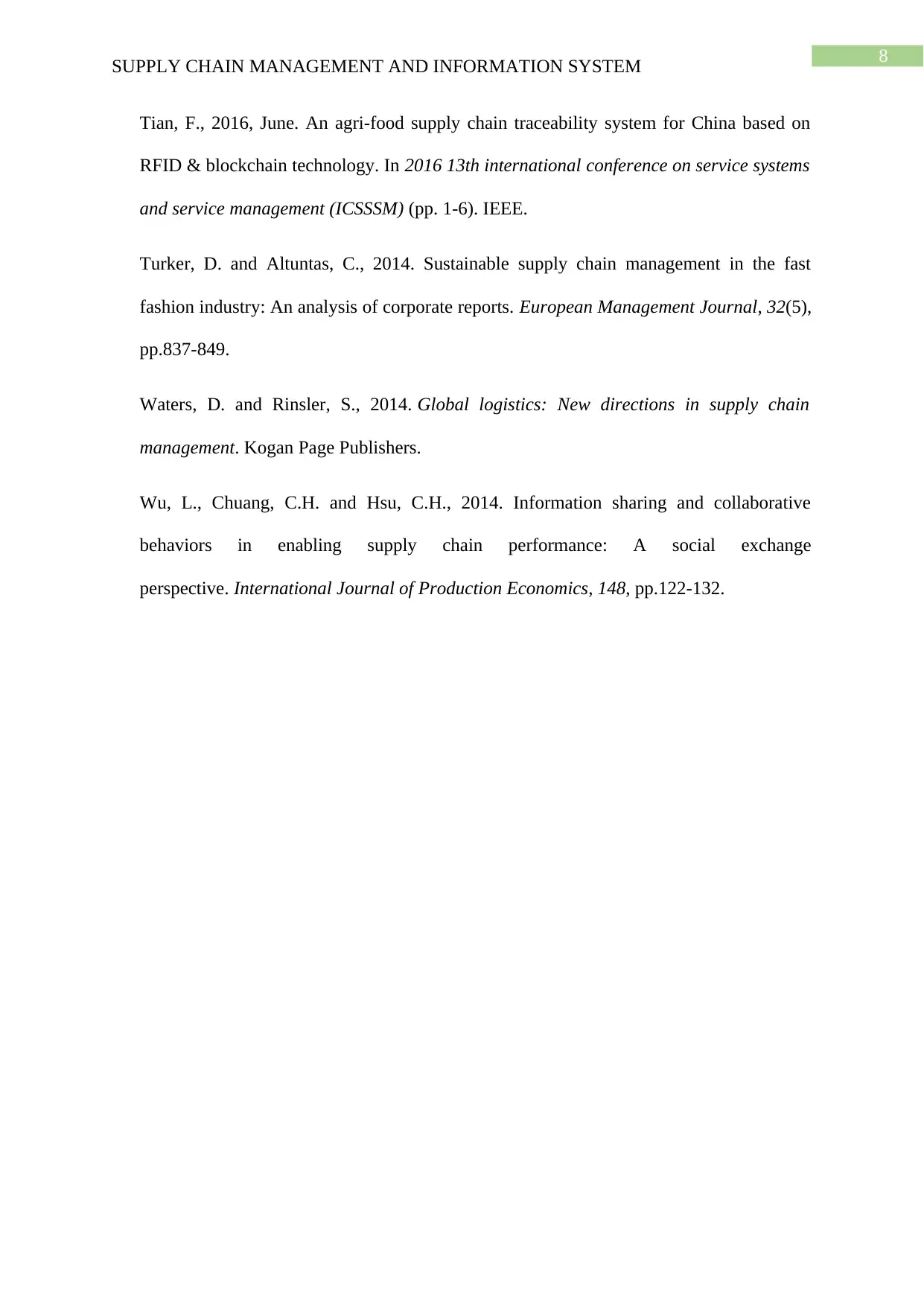
8
SUPPLY CHAIN MANAGEMENT AND INFORMATION SYSTEM
Tian, F., 2016, June. An agri-food supply chain traceability system for China based on
RFID & blockchain technology. In 2016 13th international conference on service systems
and service management (ICSSSM) (pp. 1-6). IEEE.
Turker, D. and Altuntas, C., 2014. Sustainable supply chain management in the fast
fashion industry: An analysis of corporate reports. European Management Journal, 32(5),
pp.837-849.
Waters, D. and Rinsler, S., 2014. Global logistics: New directions in supply chain
management. Kogan Page Publishers.
Wu, L., Chuang, C.H. and Hsu, C.H., 2014. Information sharing and collaborative
behaviors in enabling supply chain performance: A social exchange
perspective. International Journal of Production Economics, 148, pp.122-132.
SUPPLY CHAIN MANAGEMENT AND INFORMATION SYSTEM
Tian, F., 2016, June. An agri-food supply chain traceability system for China based on
RFID & blockchain technology. In 2016 13th international conference on service systems
and service management (ICSSSM) (pp. 1-6). IEEE.
Turker, D. and Altuntas, C., 2014. Sustainable supply chain management in the fast
fashion industry: An analysis of corporate reports. European Management Journal, 32(5),
pp.837-849.
Waters, D. and Rinsler, S., 2014. Global logistics: New directions in supply chain
management. Kogan Page Publishers.
Wu, L., Chuang, C.H. and Hsu, C.H., 2014. Information sharing and collaborative
behaviors in enabling supply chain performance: A social exchange
perspective. International Journal of Production Economics, 148, pp.122-132.
⊘ This is a preview!⊘
Do you want full access?
Subscribe today to unlock all pages.

Trusted by 1+ million students worldwide
1 out of 9
Related Documents
Your All-in-One AI-Powered Toolkit for Academic Success.
+13062052269
info@desklib.com
Available 24*7 on WhatsApp / Email
![[object Object]](/_next/static/media/star-bottom.7253800d.svg)
Unlock your academic potential
Copyright © 2020–2025 A2Z Services. All Rights Reserved. Developed and managed by ZUCOL.




